FORD MUSTANG 2003 4.G Owners Manual
Manufacturer: FORD, Model Year: 2003, Model line: MUSTANG, Model: FORD MUSTANG 2003 4.GPages: 256, PDF Size: 2.4 MB
Page 101 of 256
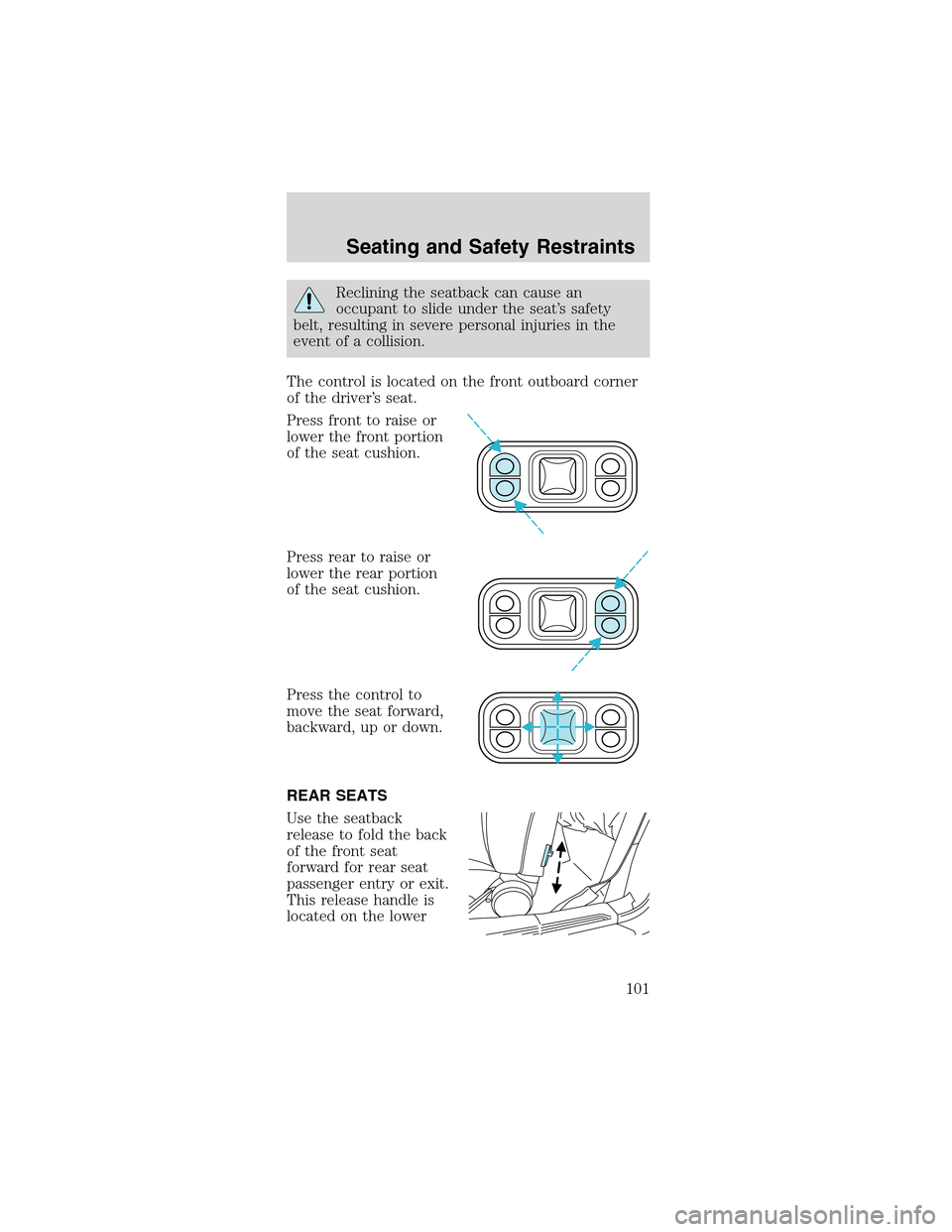
Reclining the seatback can cause an
occupant to slide under the seat’s safety
belt, resulting in severe personal injuries in the
event of a collision.
The control is located on the front outboard corner
of the driver’s seat.
Press front to raise or
lower the front portion
of the seat cushion.
Press rear to raise or
lower the rear portion
of the seat cushion.
Press the control to
move the seat forward,
backward, up or down.
REAR SEATS
Use the seatback
release to fold the back
of the front seat
forward for rear seat
passenger entry or exit.
This release handle is
located on the lower
Seating and Safety Restraints
101
Page 102 of 256

outboard back of the seat. The seatback locks
automatically when returned to the normal position.
The rotating boot on the front seat belt is designed
to allow rear seat entry/exit. To enter the rear seat:
1. Remove safety belt
from safety belt guide
on top of front seat.
2. Rotate the safety
belt boot rearward.
3. Enter the rear seat in front of the safety belt.
4. Rotate the safety belt boot forward and place the
belt in the belt guide on the seat back to allow use
by the front driver/passenger.
2nd seat/split-folding rear seat (if equipped)
One or both rear seatbacks can be folded down to
provide additional cargo space.
To lower the
seatback(s) from inside
the vehicle, pull tab to
release seat back and
then fold seatback
down.
When raising the seatback(s), make sure you hear
the seat latch into place.
SAFETY RESTRAINTS
Safety restraints precautions
Always drive and ride with your seatback
upright and the lap belt snug and low across
the hips.
Seating and Safety Restraints
102
Page 103 of 256
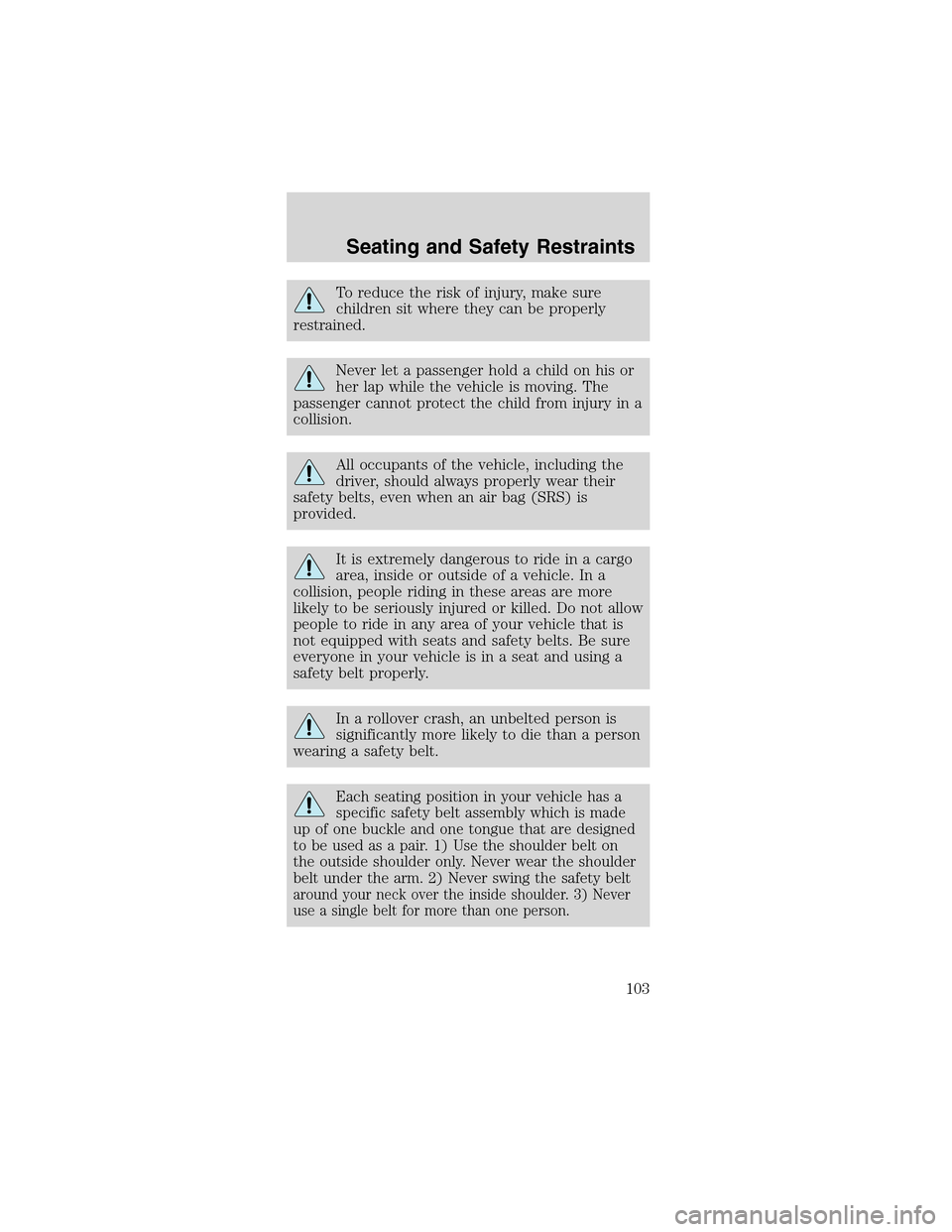
To reduce the risk of injury, make sure
children sit where they can be properly
restrained.
Never let a passenger hold a child on his or
her lap while the vehicle is moving. The
passenger cannot protect the child from injury in a
collision.
All occupants of the vehicle, including the
driver, should always properly wear their
safety belts, even when an air bag (SRS) is
provided.
It is extremely dangerous to ride in a cargo
area, inside or outside of a vehicle. In a
collision, people riding in these areas are more
likely to be seriously injured or killed. Do not allow
people to ride in any area of your vehicle that is
not equipped with seats and safety belts. Be sure
everyone in your vehicle is in a seat and using a
safety belt properly.
In a rollover crash, an unbelted person is
significantly more likely to die than a person
wearing a safety belt.
Each seating position in your vehicle has a
specific safety belt assembly which is made
up of one buckle and one tongue that are designed
to be used as a pair. 1) Use the shoulder belt on
the outside shoulder only. Never wear the shoulder
belt under the arm. 2) Never swing the safety belt
around your neck over the inside shoulder. 3) Never
use a single belt for more than one person.
Seating and Safety Restraints
103
Page 104 of 256
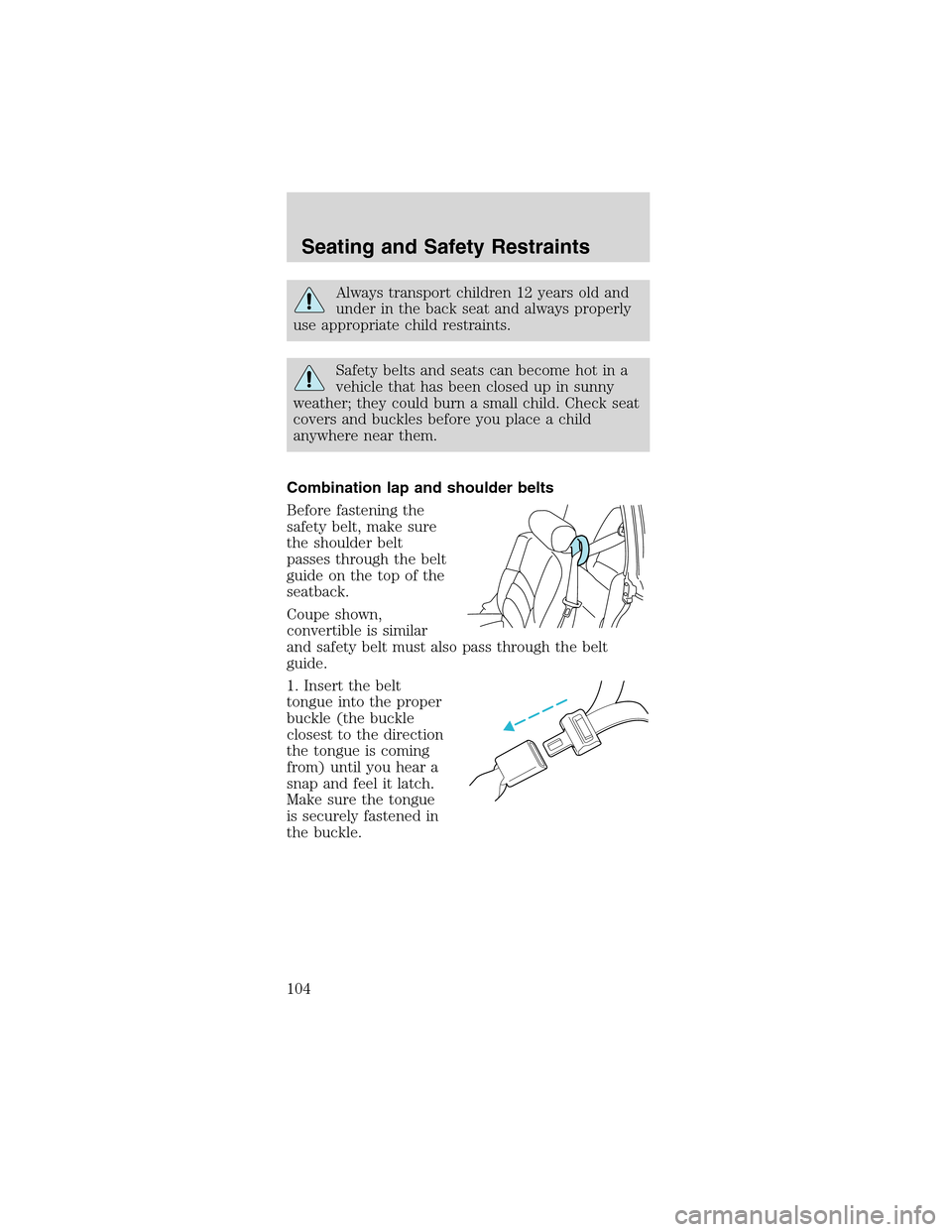
Always transport children 12 years old and
under in the back seat and always properly
use appropriate child restraints.
Safety belts and seats can become hot in a
vehicle that has been closed up in sunny
weather; they could burn a small child. Check seat
covers and buckles before you place a child
anywhere near them.
Combination lap and shoulder belts
Before fastening the
safety belt, make sure
the shoulder belt
passes through the belt
guide on the top of the
seatback.
Coupe shown,
convertible is similar
and safety belt must also pass through the belt
guide.
1. Insert the belt
tongue into the proper
buckle (the buckle
closest to the direction
the tongue is coming
from) until you hear a
snap and feel it latch.
Make sure the tongue
is securely fastened in
the buckle.
Seating and Safety Restraints
104
Page 105 of 256
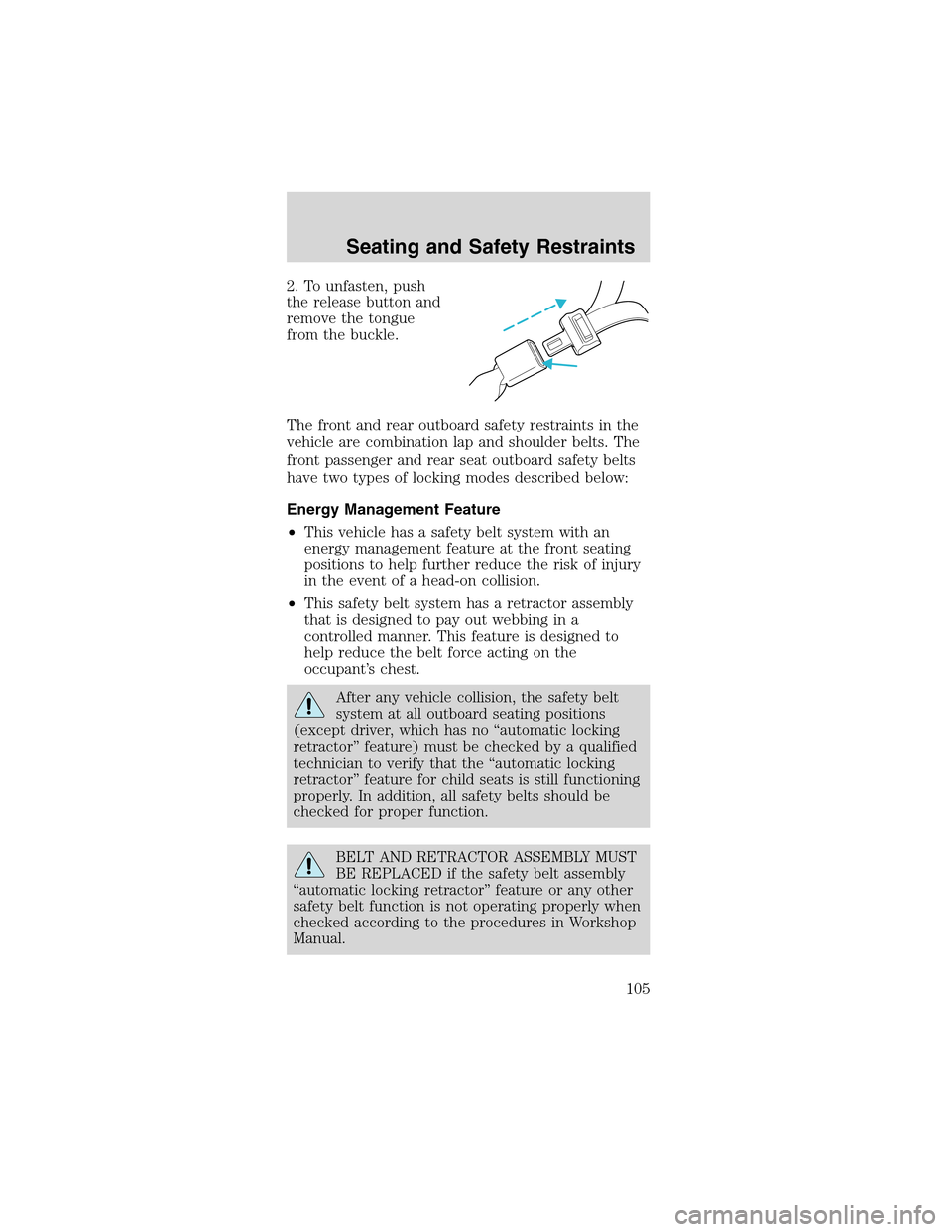
2. To unfasten, push
the release button and
remove the tongue
from the buckle.
The front and rear outboard safety restraints in the
vehicle are combination lap and shoulder belts. The
front passenger and rear seat outboard safety belts
have two types of locking modes described below:
Energy Management Feature
•This vehicle has a safety belt system with an
energy management feature at the front seating
positions to help further reduce the risk of injury
in the event of a head-on collision.
•This safety belt system has a retractor assembly
that is designed to pay out webbing in a
controlled manner. This feature is designed to
help reduce the belt force acting on the
occupant’s chest.
After any vehicle collision, the safety belt
system at all outboard seating positions
(except driver, which has no“automatic locking
retractor”feature) must be checked by a qualified
technician to verify that the“automatic locking
retractor”feature for child seats is still functioning
properly. In addition, all safety belts should be
checked for proper function.
BELT AND RETRACTOR ASSEMBLY MUST
BE REPLACED if the safety belt assembly
“automatic locking retractor”feature or any other
safety belt function is not operating properly when
checked according to the procedures in Workshop
Manual.
Seating and Safety Restraints
105
Page 106 of 256
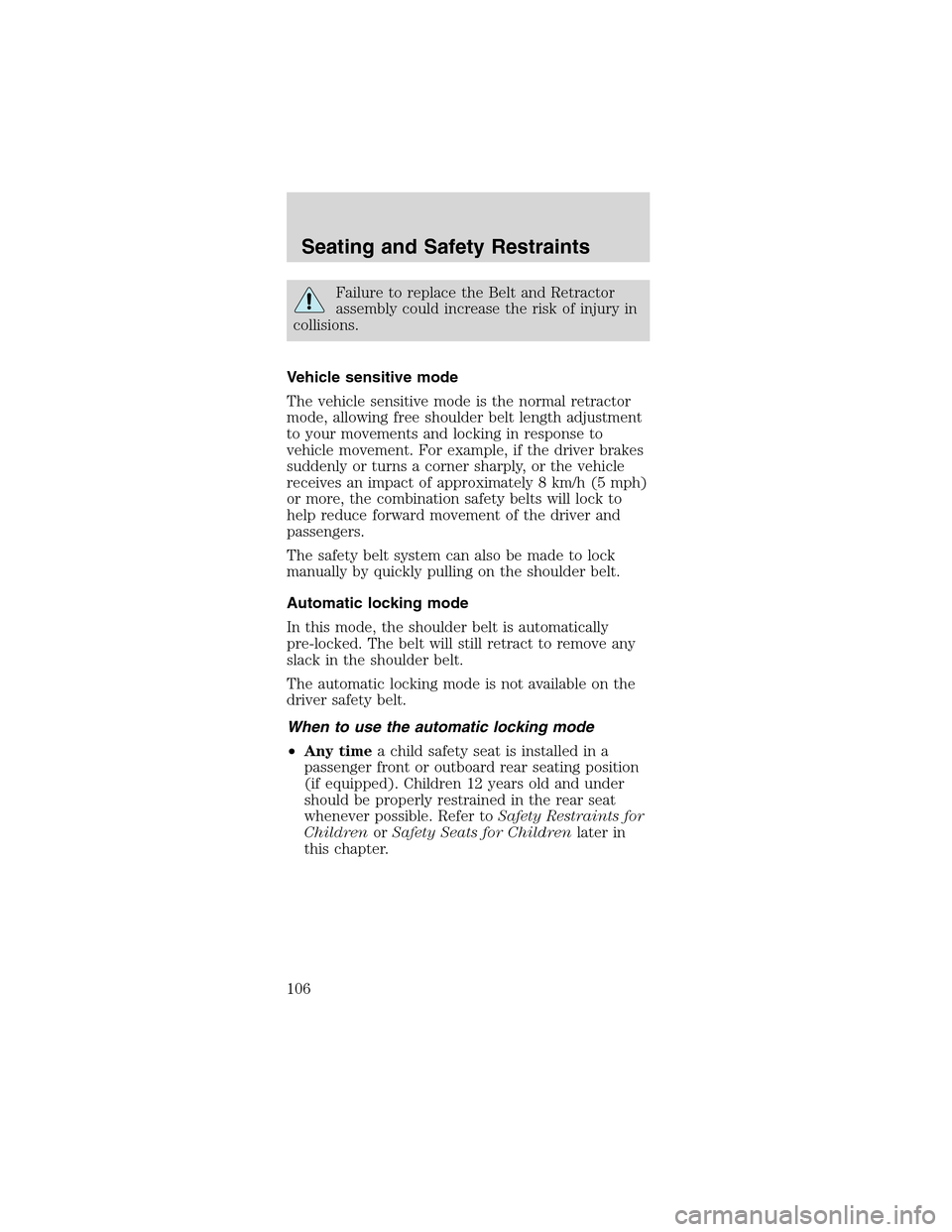
Failure to replace the Belt and Retractor
assembly could increase the risk of injury in
collisions.
Vehicle sensitive mode
The vehicle sensitive mode is the normal retractor
mode, allowing free shoulder belt length adjustment
to your movements and locking in response to
vehicle movement. For example, if the driver brakes
suddenly or turns a corner sharply, or the vehicle
receives an impact of approximately 8 km/h (5 mph)
or more, the combination safety belts will lock to
help reduce forward movement of the driver and
passengers.
The safety belt system can also be made to lock
manually by quickly pulling on the shoulder belt.
Automatic locking mode
In this mode, the shoulder belt is automatically
pre-locked. The belt will still retract to remove any
slack in the shoulder belt.
The automatic locking mode is not available on the
driver safety belt.
When to use the automatic locking mode
•Any timea child safety seat is installed in a
passenger front or outboard rear seating position
(if equipped). Children 12 years old and under
should be properly restrained in the rear seat
whenever possible. Refer toSafety Restraints for
ChildrenorSafety Seats for Childrenlater in
this chapter.
Seating and Safety Restraints
106
Page 107 of 256
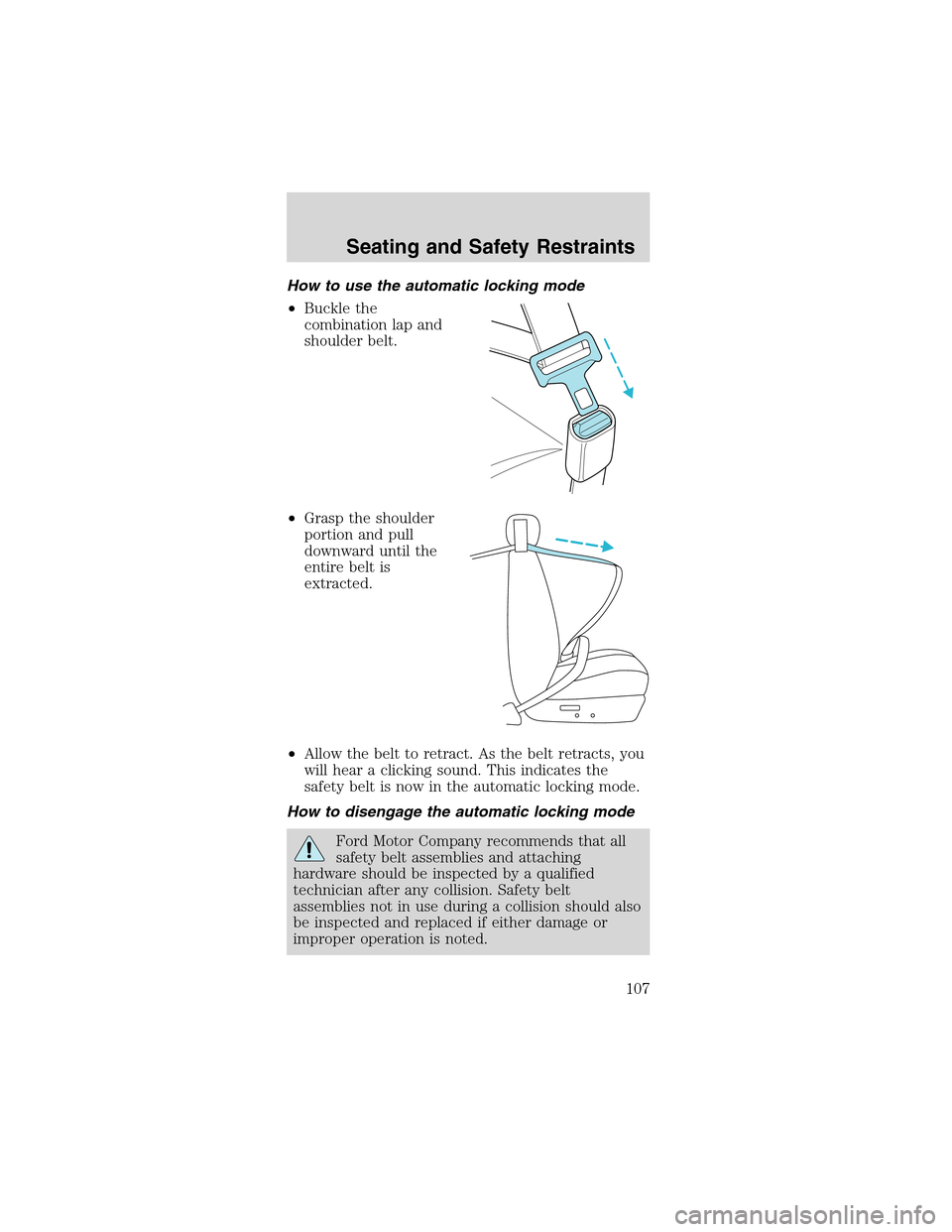
How to use the automatic locking mode
•Buckle the
combination lap and
shoulder belt.
•Grasp the shoulder
portion and pull
downward until the
entire belt is
extracted.
•Allow the belt to retract. As the belt retracts, you
will hear a clicking sound. This indicates the
safety belt is now in the automatic locking mode.
How to disengage the automatic locking mode
Ford Motor Company recommends that all
safety belt assemblies and attaching
hardware should be inspected by a qualified
technician after any collision. Safety belt
assemblies not in use during a collision should also
be inspected and replaced if either damage or
improper operation is noted.
Seating and Safety Restraints
107
Page 108 of 256
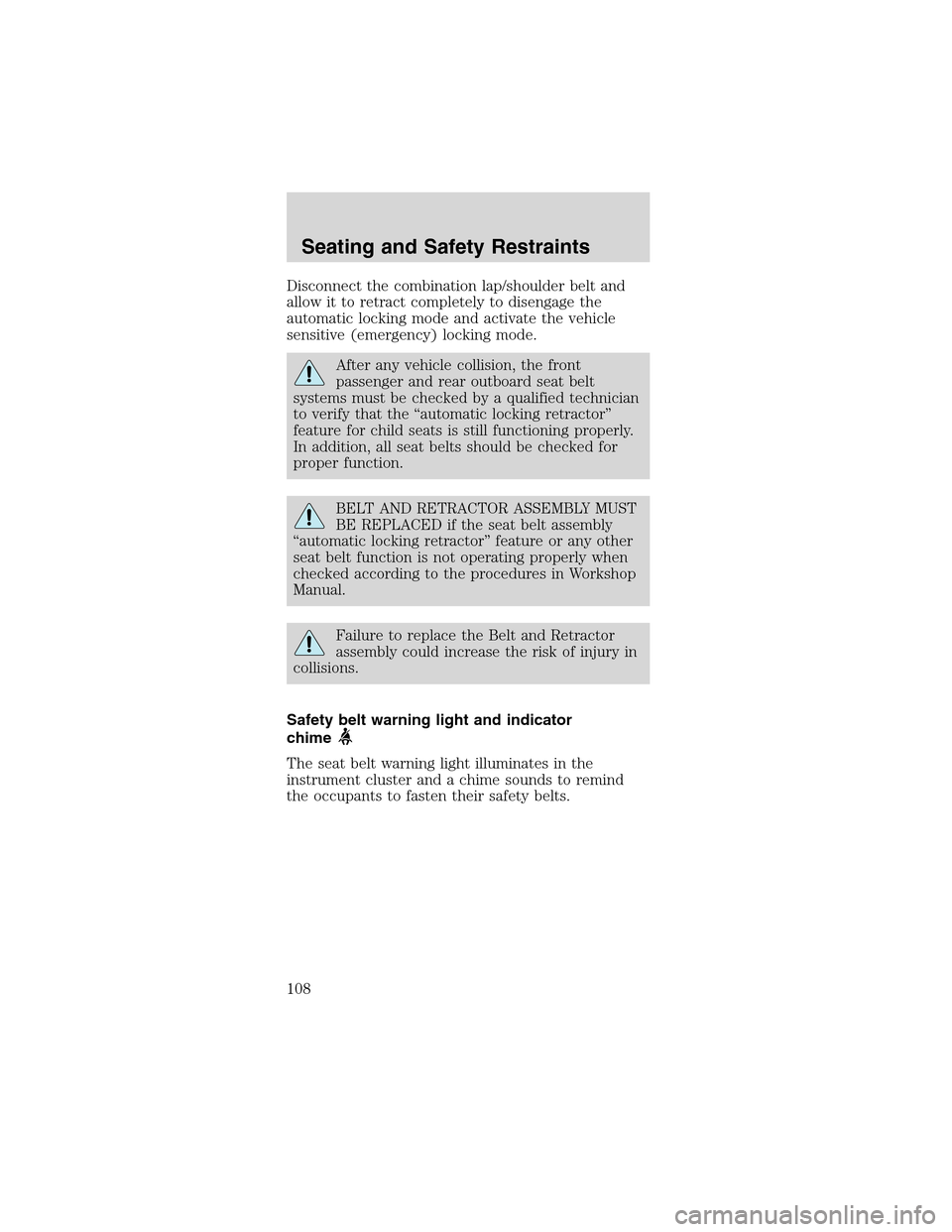
Disconnect the combination lap/shoulder belt and
allow it to retract completely to disengage the
automatic locking mode and activate the vehicle
sensitive (emergency) locking mode.
After any vehicle collision, the front
passenger and rear outboard seat belt
systems must be checked by a qualified technician
to verify that the“automatic locking retractor”
feature for child seats is still functioning properly.
In addition, all seat belts should be checked for
proper function.
BELT AND RETRACTOR ASSEMBLY MUST
BE REPLACED if the seat belt assembly
“automatic locking retractor”feature or any other
seat belt function is not operating properly when
checked according to the procedures in Workshop
Manual.
Failure to replace the Belt and Retractor
assembly could increase the risk of injury in
collisions.
Safety belt warning light and indicator
chime
The seat belt warning light illuminates in the
instrument cluster and a chime sounds to remind
the occupants to fasten their safety belts.
Seating and Safety Restraints
108
Page 109 of 256
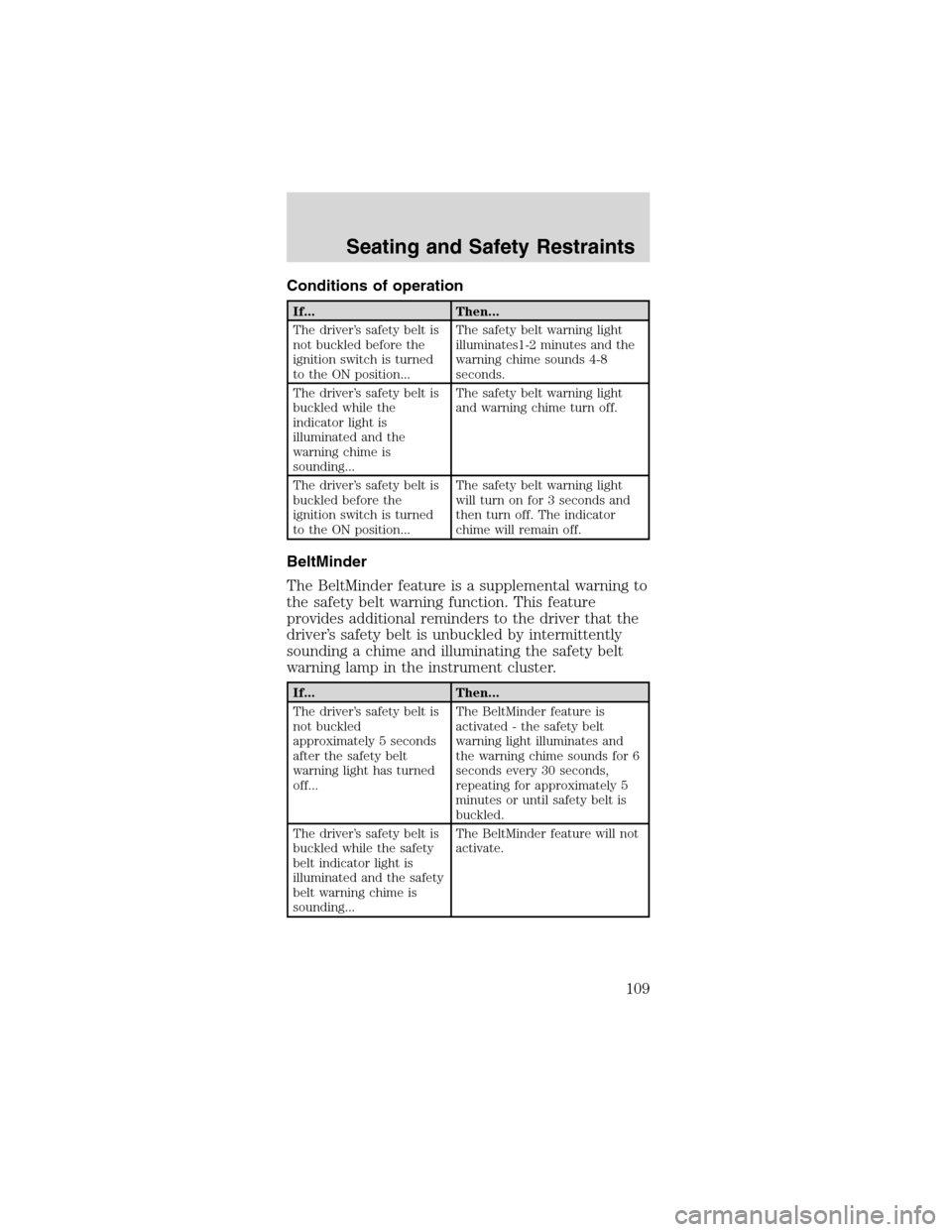
Conditions of operation
If... Then...
The driver’s safety belt is
not buckled before the
ignition switch is turned
to the ON position...The safety belt warning light
illuminates1-2 minutes and the
warning chime sounds 4-8
seconds.
The driver’s safety belt is
buckled while the
indicator light is
illuminated and the
warning chime is
sounding...The safety belt warning light
and warning chime turn off.
The driver’s safety belt is
buckled before the
ignition switch is turned
to the ON position...The safety belt warning light
will turn on for 3 seconds and
then turn off. The indicator
chime will remain off.
BeltMinder
The BeltMinder feature is a supplemental warning to
the safety belt warning function. This feature
provides additional reminders to the driver that the
driver’s safety belt is unbuckled by intermittently
sounding a chime and illuminating the safety belt
warning lamp in the instrument cluster.
If... Then...
The driver’s safety belt is
not buckled
approximately 5 seconds
after the safety belt
warning light has turned
off...The BeltMinder feature is
activated - the safety belt
warning light illuminates and
the warning chime sounds for 6
seconds every 30 seconds,
repeating for approximately 5
minutes or until safety belt is
buckled.
The driver’s safety belt is
buckled while the safety
belt indicator light is
illuminated and the safety
belt warning chime is
sounding...The BeltMinder feature will not
activate.
Seating and Safety Restraints
109
Page 110 of 256
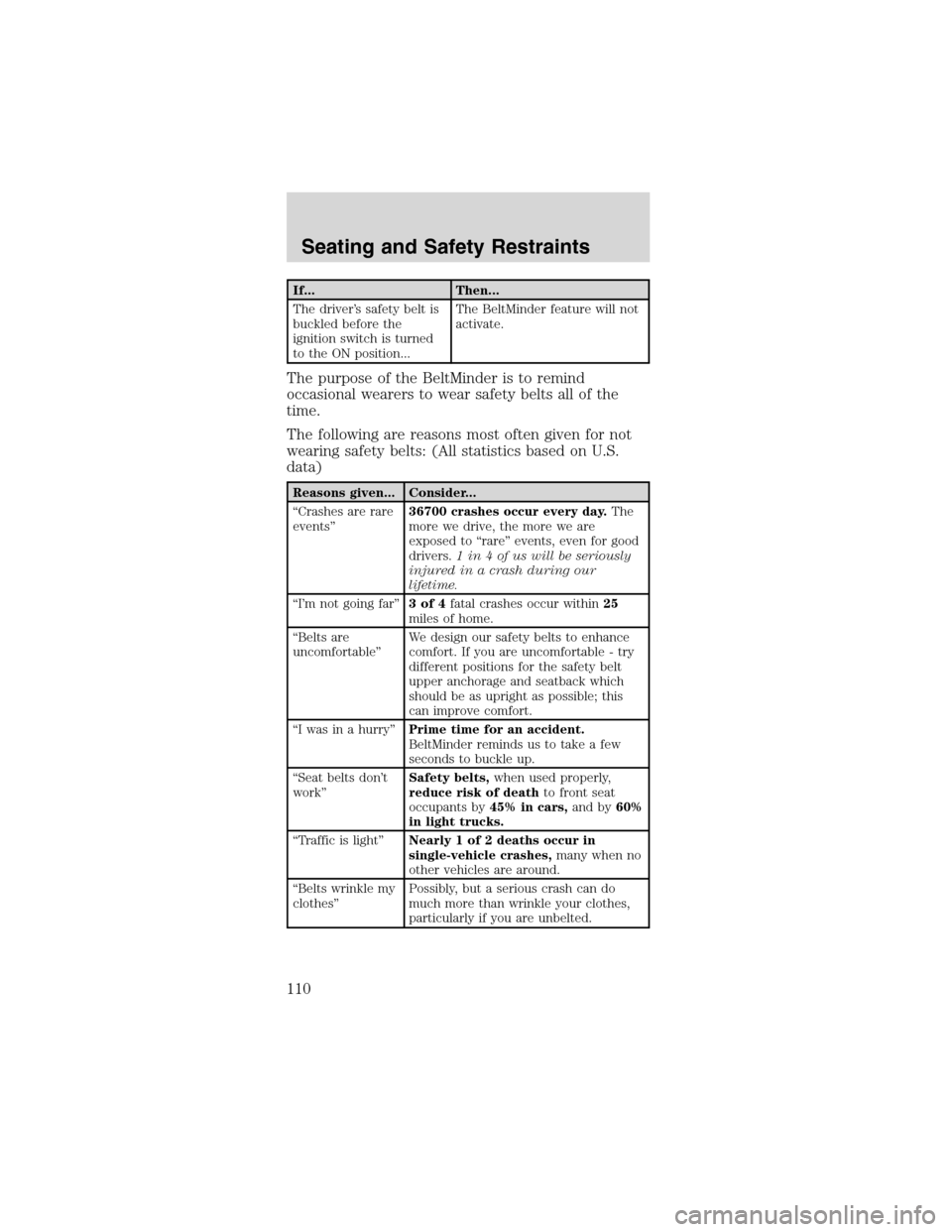
If... Then...
The driver’s safety belt is
buckled before the
ignition switch is turned
to the ON position...The BeltMinder feature will not
activate.
The purpose of the BeltMinder is to remind
occasional wearers to wear safety belts all of the
time.
The following are reasons most often given for not
wearing safety belts: (All statistics based on U.S.
data)
Reasons given... Consider...
“Crashes are rare
events”36700 crashes occur every day.The
more we drive, the more we are
exposed to“rare”events, even for good
drivers.1 in 4 of us will be seriously
injured in a crash during our
lifetime.
“I’m not going far”3of4fatal crashes occur within25
miles of home.
“Belts are
uncomfortable”We design our safety belts to enhance
comfort. If you are uncomfortable - try
different positions for the safety belt
upper anchorage and seatback which
should be as upright as possible; this
can improve comfort.
“I was in a hurry”Prime time for an accident.
BeltMinder reminds us to take a few
seconds to buckle up.
“Seat belts don’t
work”Safety belts,when used properly,
reduce risk of deathto front seat
occupants by45% in cars,and by60%
in light trucks.
“Traffic is light”Nearly 1 of 2 deaths occur in
single-vehicle crashes,many when no
other vehicles are around.
“Belts wrinkle my
clothes”Possibly, but a serious crash can do
much more than wrinkle your clothes,
particularly if you are unbelted.
Seating and Safety Restraints
110